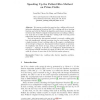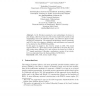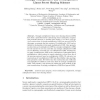100
click to vote
ASIACRYPT
2008
Springer
15 years 2 months ago
2008
Springer
This paper studies the application of slide attacks to hash functions. Slide attacks have mostly been used for block cipher cryptanalysis. But, as shown in the current paper, they ...
101
Voted
ASIACRYPT
2008
Springer
15 years 2 months ago
2008
Springer
MISTY1 is a Feistel block cipher that received a great deal of cryptographic attention. Its recursive structure, as well as the added FL layers, have been successful in thwarting v...
ASIACRYPT
2008
Springer
15 years 2 months ago
2008
Springer
88
Voted
ASIACRYPT
2008
Springer
15 years 2 months ago
2008
Springer
Abstract. We propose a method to speed up the r-adding walk on multiplicative subgroups of the prime field. The r-adding walk is an iterating function used with the Pollard rho alg...
ASIACRYPT
2008
Springer
15 years 2 months ago
2008
Springer
Abstract. In [6], Biryukov presented a new methodology of stream cipher design, called leak extraction. The stream cipher LEX, based on this methodology and on the AES block cipher...
90
Voted
ASIACRYPT
2008
Springer
15 years 2 months ago
2008
Springer
Recently, Desmedt et al. studied the problem of achieving secure n-party computation over non-Abelian groups. They considered the passive adversary model and they assumed that the...
108
click to vote
ASIACRYPT
2008
Springer
15 years 2 months ago
2008
Springer
Abstract. The generic (aka. black-box) group model is a valuable methodology for analyzing the computational hardness of number-theoretic problems used in cryptography. Since the p...
96
Voted
ASIACRYPT
2008
Springer
15 years 2 months ago
2008
Springer
In a proof-of-retrievability system, a data storage center must prove to a verifier that he is actually storing all of a client's data. The central challenge is to build syst...
107
click to vote
ASIACRYPT
2008
Springer
15 years 2 months ago
2008
Springer
Optimistic fair exchange (OFE) is a protocol for solving the problem of exchanging items or services in a fair manner between two parties, a signer and a verifier, with the help o...
105
click to vote
ASIACRYPT
2008
Springer
15 years 2 months ago
2008
Springer
Strongly multiplicative linear secret sharing schemes (LSSS) have been a powerful tool for constructing secure multi-party computation protocols. However, it remains open whether o...



